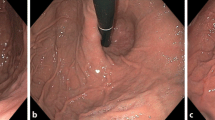Abstract
Introduction
Combined 24-h multichannel intralumenal impedance–pH monitoring (MII-pH) is gaining popularity as a diagnostic tool for gastroesophageal reflux. Since the surgical reduction of hiatal hernias and creation of a fundoplication anatomically restores the gastroesophageal reflux barrier, one would assume that it effectively stops all reflux regardless of composition. Our aim is to evaluate the results of routine MII-pH testing in successful Nissen fundoplication patients.
Material and Methods
Sixty-two patients with normal acid exposure, confirmed by 24-h pH testing, after Nissen fundoplication were evaluated with symptomatic questionnaire, esophageal manometry and MII-pH testing more than 6 months after surgery. Patients were grouped into normal and abnormal based on postoperative impedance results. Patients with Nissen alone were separately compared to patients with Nissen + giant hiatal hernia (GHH).
Results
Twenty-nine (47%) patients exhibited abnormal impedance after successful Nissen fundoplication. Abnormal impedance was associated with GHH repair, lower bolus pressures, and lower distal esophageal contraction amplitudes.
Conclusion
Postoperative testing with the standard MII-pH catheters using published normative values seems to be clinically irrelevant. Clinicians should analyze the results of routine MII-pH testing in the setting of a fundoplication critically as the current technology is associated with a high false positive rate.
Similar content being viewed by others
References
Spechler SJ. Surgery for gastroesophageal reflux disease: esophageal impedance to progress? Clin Gastroenterol Hepatol 2009;7(12):1264–5.
Dean BB, Gano AD, Knight K, et al. Effectiveness of proton pump inhibitors in nonerosive reflux disease. Clin Gastroenterol heatol. 2004;2:654–5.
Sontag SJ, O’Connel S, Khandelwal S et al. Asthmatics with gastroesophageal reflux: long term results of a randomized trial of medical and surgical therapies. Am J Gastroenterol. 2003;98:987–99.
Gruebel C, Linke G, Tutuian R, Hebbard G, Zerz A, Meyenberger C, et al. Prospective Study Examinming the Impact of Multichannel Intralumenal Impedance on Antireflux Surgery. Surg Endosc. 2008;22:1241–7.
Mainie I, Tutuian R, Agrawal A, Adams D, Castell DO. Combined multichannel intraluminal impedance-pH monitoring to select patients with persistent gastro-oesophageal reflux for laparoscopic Nissen fundoplication. Br J Surg. 2006 Dec;93(12):1483–7.
del Genio G, Tolone S, del Genio F, Aggarwal R, d’Alessandro A, Allaria A, et al. Prospective assessment of patient selection for antireflux surgery by combined multichannel intraluminal impedance pH monitoring. J Gastrointest Surg. 2008 Sep;12(9):1491–6.
Anvari M, Allen C, Marshall J, Armstrong D, Goeree R, Ungar W, et al. A randomized controlled trial of laparoscopic nissen fundoplication versus proton pump inhibitors for treatment of patients with chronic gastroesophageal reflux disease: One-year follow-up. Surg Innov. 2006 Dec;13(4):238–49.
Lundell L, Miettinen P, Myrvold HE et al. Continued follow-up of a randomized clinical study comparing antireflux surgery and omeprazole in gastroesophageal reflux disease. J Am Coll Surg. 2001;192(192):172–9.
Spechler S. Comparison of medical and surgical therapy for complicated gastroesophageal reflux disease in veterans. The Department of Veterans Affairs Gastroesophageal Reflux Disease Study Group [see comments]. N Engl J Med. 1992;326(12):786–92.
Khajanchee YS, O’Rourke RW, Lockhart B, Patterson EJ, Hansen PD, Swanstrom LL. Postoperative symptoms and failure after antireflux surgery. Arch Surg. 2002 Sep;137(9):1008–13; discussion 13–4.
Diwan TS, Martinec DV, Ujiki MB, Dunst CM, Swanstrom LL. A simplified technique for placement of biologic mesh in paraesophageal hernia repair (PEH). Surg Endosc. 2010 Jan;24(1):221–2.
Shay S, Tutuian R, Sifrim D, Vela M, Wise J, Balaji N, et al. Twenty-four hour ambulatory simultaneous impedance and pH monitoring: a multicenter report of normal values from 60 healthy volunteers. Am J Gastroenterol. 2004 Jun;99(6):1037–43.
Johnson LF, Demeester TR. Twenty-four-hour pH monitoring of the distal esophagus. A quantitative measure of gastroesophageal reflux. Am J Gastroenterol. 1974 Oct;62(4):325–32.
del Genio G, Tolone S, Del Genio F, Rossetti G, Brusciano L, Pizza F, et al. Total fundoplication controls acid and nonacid reflux: evaluation by pre- and postoperative 24-h pH-multichannel intralumenal impedance. Surg Endosc. 2008;22:2518–23.
Author information
Authors and Affiliations
Corresponding author
Rights and permissions
About this article
Cite this article
Arnold, B.N., Dunst, C.M., Gill, A.B. et al. Postoperative Impedance–pH Testing is Unreliable After Nissen Fundoplication With or Without Giant Hiatal Hernia Repair. J Gastrointest Surg 15, 1506–1512 (2011). https://doi.org/10.1007/s11605-011-1597-4
Received:
Accepted:
Published:
Issue Date:
DOI: https://doi.org/10.1007/s11605-011-1597-4




